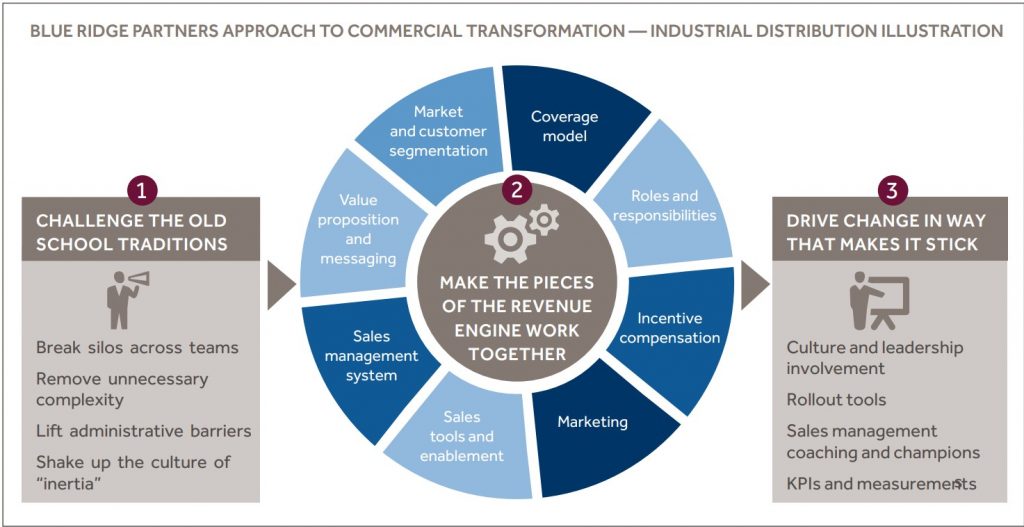Taking Sales in Distribution Companies off the Autopilot
Many industrial distribution companies have established robust commercial organizations, built reliable customer bases, and developed solid sales processes. Yet a significant number lack growth momentum, face decreasing margins, or both. These companies operate on “autopilot”, executing against “business as usual” and missing opportunities to use some of the best commercial practices that have been adopted in other industries.
Much of the problem stems from the environment in which they operate. The industrial distribution industry, especially in Europe, is still fragmented and operations of larger groups are highly localized. As a result, many companies are content to win a certain percentage of their market year after year but are unable to accelerate growth by gaining a larger share of wallet among their customer bases or by growing their market share.
Industry consolidation has offered some promise of change with larger groups adopting more commercially astute sales approaches. On the whole, however, there remains a significant opportunity for industrial distributors to accelerate top-line growth by fine-tuning their Go-to-Market model, boosting discipline around their sales process, and adopting best-practice sales effectiveness tools.
This presents a significant opportunity. Industrial distribution companies that transform the way they sell, leverage modern technology and processes and apply commercial best practices are well positioned to capture increased market share of a still-fragmented market and drive growth.
Three-stage commercial transformation
Blue Ridge Partners has worked with dozens of industrial distribution companies across Europe and the U.S., helping them address commercial challenges and accelerate top-line growth. Based on what we’ve seen, we have developed a three-stage process that is highly effective in enabling companies to transform their commercial organization and grow revenues:
- Stage 1: Challenge the old school traditions. Identify and lift internal barriers and organizational complexity that are hampering effective selling.
- Stage 2: Make the pieces of the revenue engine work together. Review all elements of the commercial model and align them to enable the organization to act more effectively, and with more intent, against growth opportunities.
- Stage 3: Drive change in a way that makes it stick. Drive growth by changing the culture, setting up KPIs, instituting a coaching-focused sales management function, and introducing the tools needed to sell effectively. Maintain momentum beyond the initial uplift.

Stage 1: Challenge the old school traditions
Industrial distribution companies often have established commercial fundamentals and key processes that have not changed for years. Many companies, especially in Europe, have regional sales teams with limited experience outside the industry and little exposure to best-in-class sales practices, resulting in people often simply not knowing what “good” looks like. Additionally, common tools to instill consistent sales approaches such as Playbooks are often absent. As a result, they unwittingly create barriers to their own growth.
Companies often get to this point unnoticed, requirements are added to the sales organization and process layer upon layer until a degree of complexity has been reached that poses real challenges – call it “death by a thousand papercuts”. Even acknowledging and addressing this complexity, created gradually over time, can be a major win.
Here are some common internal barriers we have seen and recommend tackling first:
- Organizational silos. M&A activity among distributors can result in poor sales force integration, limited cross-training, duplication of work, and multiple cultures living alongside each other, often not collaboratively. Silos between local branches and national key account teams, and between sales and operations, are common inhibitors among industrial distribution companies.
- Organizational complexity. Often companies create organizational structures which produce inherent conflicts leaving money on the table – e.g., two sales reps calling on the same customer or sales reps “driving past” opportunities within ill-defined territories. In industrial distribution organizations with wider branch networks, we often see significant inconsistency across branches and sales rep performance. In businesses with a large footprint, we have seen sales reps “going native”, where customer focus is to the exclusion of finding new opportunities for growth among current or new customers.
- Administrative burdens. Excessive use of paper-based processes, burdensome approvals, inefficient quoting and delivery processes, and limited or inefficient use of digital tools (ERPs, CRM, lead generation, marketing tools, etc.) all lead to low levels of responsiveness to customers and “death by a thousand papercuts”. Compliance intentions are often healthy, but these processes can become burdensome over time when they go unchecked.
- Culture of inertia. Content with “business as usual”, we have often seen a widespread lack of entrepreneurial spirit, lack of a “culture of winning”, an attitude toward “order taking” as opposed to proactive selling, and either too technology-focused communications or its opposite lack of technical understanding within the sales and operational teams.
Addressing these barriers is the first step in transforming commercial organizations. Even very small actions, such as eliminating management approvals for small-ticket items and reducing redundant steps in a quotation process can result in “quick wins” towards commercial transformation. We have seen the lifting of barriers has a profound effect on the motivation of local sales teams, leaving them feeling more empowered. Senior leadership’s open and candid acknowledgment of the administrative barriers, coupled with a transparent plan to fix them and communication of achievements generates initial trust among customer-facing teams.
Stage 2: Make the pieces of the revenue engine work together
Most industrial distribution companies have several or sometimes many of their commercial levers functioning well but lack alignment between them. They don’t work in sync. This is a problem because alignment is key to the success of a commercial transformation. For example, if companies in a certain size bracket are considered to be a top growth target, external sales reps should have growth in this segment prioritized in their named account lists, recognized in their incentive compensation plan, and adequately supported by marketing, etc.
While the exact levers of commercial effectiveness will differ for every company, here are the commercial model elements that we have seen most frequently among industrial distribution companies:
- Market and customer segmentation. Many industrial companies fall into the trap of believing they fully know their customer bases and the needs of those customers. When existing customers and incoming orders keep the sales teams busy, it becomes tempting to ignore non-customers or less familiar segments and miss important new players coming in. For sales reps, focusing not just on what they sell to customers but also on what they don’t sell and who they don’t sell to, can break “comfort zone” habits and show significant untapped opportunity. Customer segmentation based on opportunity and evaluation of customer lifetime values are well-known tools that are not used enough by industrial distribution companies. As an illustration, a company may assume that the most headroom lies within local depots and thus miss large regional facilities that offer significant revenue opportunities with higher margins and less competition. Similar “blind spots” often occur with specific products, solutions, and industry segments.
- Coverage model. Many industrial distribution companies assign their sales resources based on past sales results or legacy structures. Conducting a detailed market sizing study with estimated opportunity by the company is often eye-opening. It gives managers crucial evidence to focus the sales teams on the largest and most relevant opportunities rather than just looking back. For example, one experienced branch manager at a European industrial distributor was shocked to see his existing customer base covered only 20% of the market opportunity in the territory with some of the biggest potential targets being literally next door and never called upon. We helped the company estimate an unaddressed market opportunity worth more than 1 billion Euros in just one key market – a critical step in getting their salespeople to stop calling solely on the same people at the same customers.
- Value proposition and messaging. Industrial distribution companies often underestimate the importance of value messaging and fall into the trap of transactional sales. Clearly articulating the right value message aligned to the right customer buyer values, and not over-complicating can be an important differentiator. Understanding the broader needs of customers in different segments is the foundation for developing effective value
- propositions and messaging. Once developed, it is important to document value messages in the form of scripts and templates and train external and internal salespeople to use them. At one company, the internal sales team was challenged by the low availability of rare stock items and often had to tell customers, “We don’t have this item in stock; it will take four weeks to deliver it”. We asked them to experiment with new phrasing around straightforward “value messaging pillars”, saying instead, “We can arrange to get this item for you. When are you installing it?” It turned out that most customers did not need the item urgently and could wait the four weeks. The company now reserves available stock for only urgent needs, enabling it to meet the timelines of both buying situations and raising customer perceptions of the business’s ability to meet their needs.
- Roles and responsibilities. Industrial distribution companies often have multiple sales and operational roles, including external sales, internal sales, branch managers, regional managers, delivery managers, and service managers. It is not uncommon to see these roles vary across regions and branches. At the same time, duplication and lack of clarity between roles often prevent people from performing effectively. We have seen situations where sales reps’ own assessment of their “Skill and Will” levels are vastly higher than the assessment by their managers, indicating lacking grasp of “what good looks like”. We have also seen reps go well beyond their roles to the exclusion of selling – e.g., reps doing deliveries instead of visiting new prospects. Consistent role descriptions, RACI matrices, and best practices packaged in the form of Playbooks by role are a very effective solution.
- Sales management system. Sales management trumps sales executives and reps. In other words, a high-performing sales management layer – far more than an effective executive or sales rep layer – is the key to sustaining high performance over time, embedding momentum after an initial sales effectiveness uplift. We have often seen sales managers in industrial distribution companies not spend enough time coaching, have conflicting interests between meeting their own quota and coaching, or even compete with their own team members for deals, thus undermining team results. By getting sales managers focused on coaching with a regular cadence of one-to-ones, ride-along, and sales team meetings, sales managers and their teams learn and develop selling skills. Sales managers should spend at least 50% of their time coaching their reps, but our experience has found the percentage of coaching time is usually far less than that.
- Incentive compensation. Aligning incentive compensation with the business objectives is one of the most important drivers of commercial effectiveness. However, most incentive compensation schemes fail to incentivize the right behaviors and drive the results that leadership wants to see. For example, one company’s objective was profitable growth, but its incentive compensation focused on gross margins of pre-assigned accounts only. This resulted in high margins but declining sales and gave salespeople no incentive to go out and find new business. By changing the plan to focus on gross profit growth and putting in place accelerators to reward high performance, the company aligned incentives with the core business objective.
- Sales tools and enablement. While most industrial distribution companies have ERP and CRM systems in place, these tools are often outdated, and their use of them is irregular and inconsistent. Implementing simple and effective tools to track customer insights and customer interactions is critical, but sales forces generally don’t believe that the tools will help them. To address this challenge, one company that was transforming its CRM system to adapt to a new sales model involved field sales from the outset and embedded the parameters solidly into the sales process rather than allow an IT-led process. The company got feedback from its sales teams, incorporated that feedback into the system, created buy-in, and trained local champions who helped drive adoption and usage of the system.
- Marketing. Typically, industrial distribution companies do not spend a lot on marketing. However, even a modest investment in tailored marketing materials and campaigns can help differentiate in a competitive environment. When one company realized it had lost market share in its signature product line, marketers created a campaign and called on all their down-trading customers to ask when they were going to replenish their stocks of the company’s product. This marketing effort gave sales reps a good reason to reconnect with customers and resulted in product sales growth.
Stage 3: Drive change in the way that makes it stick
When transforming commercial organizations into industrial distribution companies, we find that pilots are very useful for testing and refining the elements and, even more importantly, for
getting feedback from the teams and building their trust. Once pilots are completed, it becomes very important to consistently execute and maintain momentum. There are four key elements to effective execution:
- Culture and leadership involvement. Culture is key to making changes stick. However, it is very hard to change and measure. Through our work with industrial distribution companies in Europe and the U.S., we have identified three types of activities that generate high levels of trust from teams and thus contribute to a cultural shift. All these elements are related to leadership behavior, as we’ve found that leadership starts the culture transformation:
- Leadership “walking the talk”. This includes setting a clear growth strategy, effectively communicating that strategy to local teams, and communicating example actions that each leadership team member takes to execute the strategy. In one company, the leaders committed to a “top-to-top” meeting with each of its top 100 customers and made some quick decisions to show commitment.
- Transparency and commitment. Leadership shows transparency in decisions and personal commitment to helping the company address barriers to growth.
Acknowledging existing administrative barriers and silos, discussed in Stage 1, is an important step which generates trust among local teams. An open style of communicating the rationale for major changes (e.g., compensation, organizational changes) is another way to develop trust that teams highly appreciate. - Presence in the organization. A leadership presence at local branches for Q&A sessions, to address concerns, explain the changes and plans, etc. is crucial. When leadership participates in ride-along, branch meetings, and customer calls, it can generate a lot of positive buzz and excitement at the branch level.
- Roll-out tools. Industrial distribution companies often have broad networks of relatively independent branches, which can complicate the effective rollout of tools. One way to address this challenge is with rollout kits. We helped one European distributor of industrial spare parts create rollout toolkits with sales effectiveness tools tailored to each branch, including target customer lists with market-driven estimates of potential opportunity, value messaging and strategy templates aligned to their territories, incentive compensation calculators, and a set of Playbooks for both sales managers and reps. Creating a schedule of regional or branch rollouts involving management and led by sales managers is key to supporting the cultural element of the rollout.
- Sales management. The success of any transformation depends on buy-in and adoption by sales management. When management kick-starts the transformation and sets the pace, we typically see a successful outcome. Without their involvement, it is hard to achieve the scale of change often required. Briefings and training sessions with the managers, train-the-trainer programs, and appointing local champions are all important steps to making sure the high-level strategy is effectively executed locally. One company experienced good results when it trained its sales managers to communicate the strategy and resulting changes. At their annual sales conference, sales managers presented the new commercial approach to their teams, which gave sales teams assurance that their managers were on board. It also gave team members an opportunity to ask questions and address concerns.
- KPIs and measurement. Culture change, which is arguably the most important element of a successful transformation, is hard to measure. However, introducing a clear set of relevant KPIs for each branch, region, and role helps drive people in the same direction and holds them accountable. Branch- or region-level, visual dashboards with key metrics (such as branch sales growth, sales growth per customer segment, number of new logos, lines, and locations) that everyone in a branch can see get everyone onto the same page and point in the same direction. One company that did this also introduced competition to become the highest-achieving sales person. It brought in bells to celebrate new customer wins. These celebrations, calling out team-based targets and winners, created a culture of entrepreneurship and boosted energy levels and focus.
Delivering results
Blue Ridge Partners has seen this three-stage approach to commercial transformation work many times. Take the example of one European industrial distribution company. The company was facing declining sales, high employee turnover, siloed legacy sales teams, and an uninspiring culture with significant administrative burdens. People at the top were making poor decisions resulting in the company being forced to close local depots and branches at an alarming rate. Long-standing relationships with buyers began to suffer.
We assisted this organization through the three-step process described above. After piloting changes at a sub-set of the company’s local branches, tracking results, and making adjustments, we rolled out the model to the rest of the network. As a result of the transformation effort, the company has reversed its sales decline and reignited its revenue growth engine, so it is now achieving positive growth momentum. It has deepened existing customer relationships and developed new ones. Above all, a top-down change in culture has created a more entrepreneurial and empowered organization that is able to deliver on growth opportunities. This is not isolated but is representative of a broader set of engagements in industrial distribution both in Europe and in the U.S.


